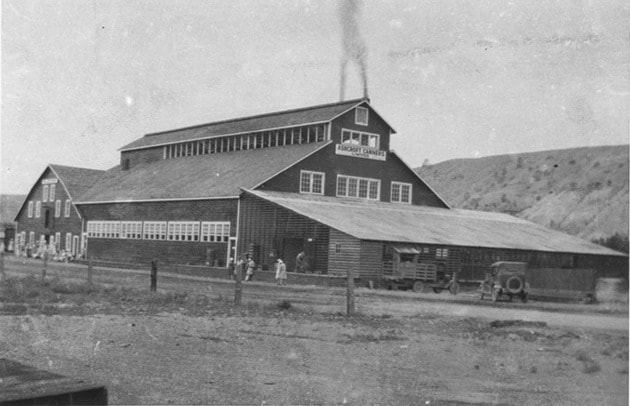In the early 1920s, Ashcroft was reeling economically because of a double whammy that almost spelled the end of the town. The fire in 1916 had wiped out most of the town’s business district, and while some businesses were quick to rebuild, others (such as the town’s hotels) were not. And the end of World War I in 1918 saw men streaming home, looking for jobs which in many cases had vanished.
That was all too apparent in Ashcroft. Since its founding, the town had relied on being a transportation hub; but other railway companies had sprung up to provide competition for the Canadian Pacific, and driven the stagecoaches out of business. With the death of the stagecoaches, the firms that made them run—the livery stables, blacksmith shops, harness- and carriage-makers—also vanished. Ashcroft was facing a tough time, and something big was needed to keep it from going under.
The answer was, quite literally, under everyone’s noses. Early settlers had realized that the land around Ashcroft was rich and fertile—if one could only get enough water to it. In many cases it was Chinese farmers and ranchers who provided the know-how to get the water to the land, using the intensive irrigation techniques they had brought with them from farming the terraced fields of China. Water, combined with the hot sun of an Ashcroft summer, meant that many different varieties of vegetable thrived here.
By the early 1920s Ashcroft potatoes were already famous across the country. CPR dining cars served only carefully selected Ashcroft potatoes, at 35 cents each for a baked spud; this at a time when a full restaurant meal could cost less than $1.00. It was soon apparent that Ashcroft tomatoes were second-to-none: rich, ripe, and succulent. Many of the Chinese farmers in the area grew them in their market gardens, and in 1924 Willis West, who managed the BX Express Company, saw a golden opportunity.
The BX had moved their headquarters to a building (still extant) at Railway and 6th in 1912, and erected outbuildings to house their horses and equipment; but by 1923 the company had lost its contract to haul mail and passengers, and was looking for some way to utilize all the empty buildings. One day, West observed a group of local farmers loading tomatoes on to rail cars in Ashcroft, to be shipped away, and asked himself if these people couldn’t be taught to handle a cannery. Why ship the raw materials away to be processed, if it could be done in Ashcroft?
West put the idea to local land owners and to the Chinese merchants and farmers, asking if they would be able to supply the tomatoes. The answer was yes and, not without some reluctance, the BX financed the cannery. The freight barn (occupying the space where Friendship Auto and the Ministry of Children building now stand) was converted into a cannery, and a vast warehouse was built across the street from it on the other side of Railway Avenue, beside the CP rail line. A conveyor belt high above the street connected cannery and warehouse so that the finished products could be quickly and easily transported for shipping.
The cannery had contracted with local farmers to supply them with tomatoes; not just in and around Ashcroft, but as far south as Spences Bridge. Each of the four Chinese general stores in Ashcroft leased two or more local farms and began planting tomatoes, hiring local and Chinese workers from as far away as Vancouver to help with the harvest. In early spring cold frames were constructed behind the Wing Chong Tai store at the north end of Railway, to start growing the tomato bedding plants farmers would need when it came to plant the next season’s crop.
Other local farmers also hired workers from the coast when it came time for the harvest, as there simply weren’t enough locals to do the work. From mid-July to August partially ripe tomatoes were shipped south for Lower Mainland markets, but the bulk of the crop came to Ashcroft, where the cannery also made tomato juice and tomato ketchup.
Despite the misgivings of the BX, the cannery was a success from the start. Aylmer’s Cannery in Ontario was waiting for the upstart Ashcroft cannery to call for help; instead, Ashcroft sent a report back east reporting such a successful season that the management at Aylmer’s didn’t believe it. How, they asked, could the Ashcroft cannery put through that many cans of tomatoes in a season with only one closing machine? Willis West invited management to come see for themselves, and they did, only to find that the Ashcroft tomatoes were so much larger than the ones back east that the cans could be filled faster.
Next summer Aylmer’s put in a bid to buy the Ashcroft cannery; the exact result that the BX Express Company had been hoping for. That same year—1925—saw the B.C. Government purchase the BX headquarters at Railway and 6th as a courthouse and government agent’s office; so just like that, the BX Express was gone from Ashcroft, taking forty-plus years of history with it.
The cannery thrived for 23 years, employing hundreds of people—many from as far afield as the Lower Mainland—at the height of each season. By 1957, however, Canada was importing so many vegetables from the United States, at much lower prices than local farmers could offer, that the cannery was forced to close. Another factor was beef prices, which for some years had been low enough that local ranchers were happy to lease land to Chinese farmers to grow tomatoes. By 1957, however, beef prices were on the rise, and ranchers wanted their leased land back; and thus sounded the death knell of the mighty Ashcroft cannery.
